roof rack HYUNDAI TUCSON 2015 Owners Manual
[x] Cancel search | Manufacturer: HYUNDAI, Model Year: 2015, Model line: TUCSON, Model: HYUNDAI TUCSON 2015Pages: 653, PDF Size: 8.45 MB
Page 88 of 653
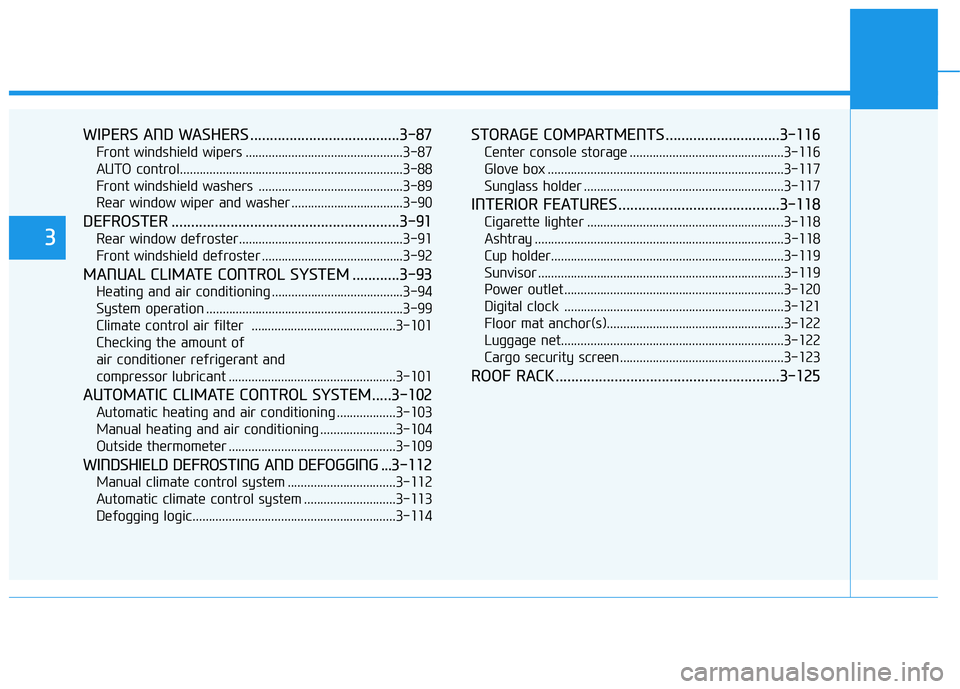
WIPERS AND WASHERS ......................................3-87
Front windshield wipers ................................................3-87
AUTO control....................................................................3-88
Front windshield washers ............................................3-89
Rear window wiper and washer ..................................3-90
DEFROSTER ..........................................................3-91
Rear window defroster..................................................3-91
Front windshield defroster ...........................................3-92
MANUAL CLIMATE CONTROL SYSTEM ............3-93
Heating and air conditioning ........................................3-94
System operation ............................................................3-99
Climate control air filter ............................................3-101 Checking the amount of
air conditioner refrigerant and
compressor lubricant ...................................................3-101
AUTOMATIC CLIMATE CONTROL SYSTEM.....3-102
Automatic heating and air conditioning ..................3-103
Manual heating and air conditioning .......................3-104
Outside thermometer ...................................................3-109
WINDSHIELD DEFROSTING AND DEFOGGING ...3-112
Manual climate control system .................................3-112
Automatic climate control system ............................3-113
Defogging logic..............................................................3-114
STORAGE COMPARTMENTS .............................3-116
Center console storage ...............................................3-116
Glove box ........................................................................3-117
Sunglass holder .............................................................3-117
INTERIOR FEATURES .........................................3-118
Cigarette lighter ............................................................3-118
Ashtray ............................................................................3-118
Cup holder.......................................................................3-119
Sunvisor ...........................................................................3-119
Power outlet ...................................................................3-120
Digital clock ...................................................................3-121
Floor mat anchor(s)......................................................3-122
Luggage net....................................................................3-122
Cargo security screen..................................................3-123
ROOF RACK .........................................................3-125
3
Page 211 of 653
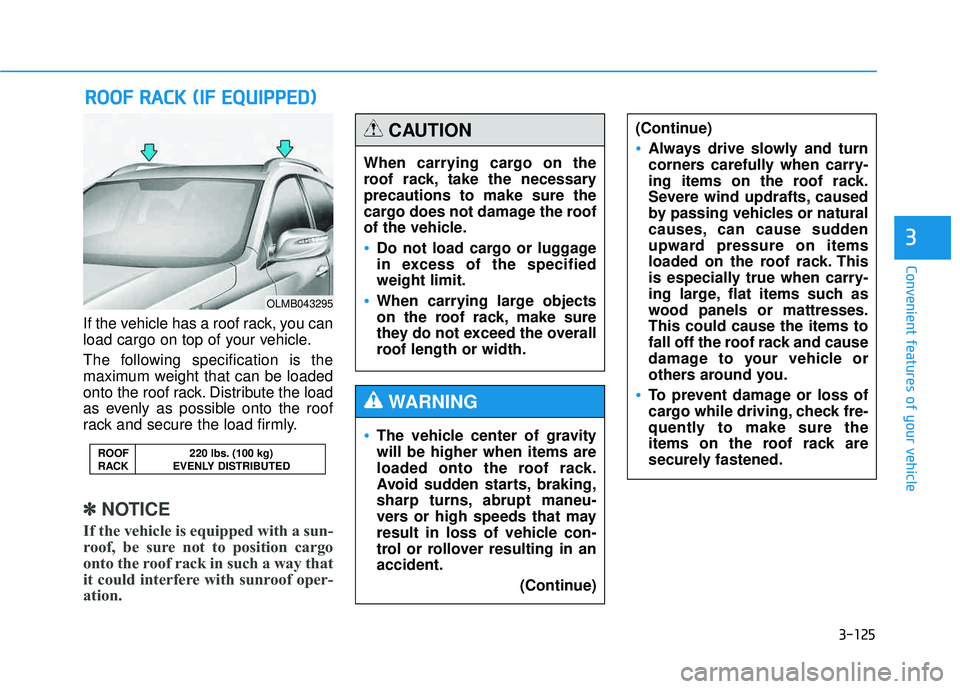
3-125
Convenient features of your vehicle
3
If the vehicle has a roof rack, you can
load cargo on top of your vehicle.
The following specification is the
maximum weight that can be loaded
onto the roof rack. Distribute the load
as evenly as possible onto the roof
rack and secure the load firmly.
✽✽NOTICE
If the vehicle is equipped with a sun-
roof, be sure not to position cargo
onto the roof rack in such a way that
it could interfere with sunroof oper-
ation.
RR OO OOFF RR AA CCKK (( IIFF EE QQ UUIIPP PPEEDD ))
ROOF 220 lbs. (100 kg)
RACK EVENLY DISTRIBUTED
OLMB043295
When carrying cargo on the
roof rack, take the necessaryprecautions to make sure the
cargo does not damage the roof
of the vehicle.
Do not load cargo or luggage
in excess of the specifiedweight limit.
When carrying large objects
on the roof rack, make sure
they do not exceed the overall
roof length or width.
CAUTION
The vehicle center of gravity will be higher when items are
loaded onto the roof rack.
Avoid sudden starts, braking,
sharp turns, abrupt maneu-
vers or high speeds that may
result in loss of vehicle con-
trol or rollover resulting in anaccident.
(Continue)
WARNING
(Continue)
Always drive slowly and turn
corners carefully when carry-
ing items on the roof rack.
Severe wind updrafts, caused
by passing vehicles or natural
causes, can cause sudden
upward pressure on items
loaded on the roof rack. This
is especially true when carry-
ing large, flat items such as
wood panels or mattresses.This could cause the items to
fall off the roof rack and cause
damage to your vehicle or
others around you.
To prevent damage or loss of
cargo while driving, check fre-
quently to make sure the
items on the roof rack are
securely fastened.
Page 213 of 653
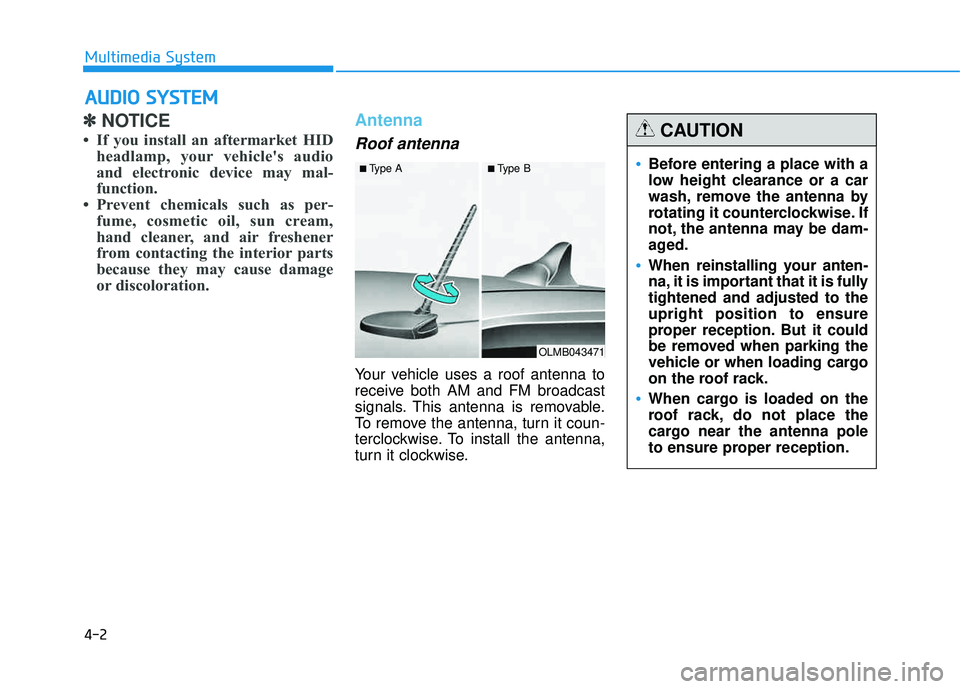
4-2
✽✽NOTICE
If you install an aftermarket HID headlamp, your vehicle's audio
and electronic device may mal-
function.
Prevent chemicals such as per- fume, cosmetic oil, sun cream,
hand cleaner, and air freshener
from contacting the interior parts
because they may cause damage
or discoloration. Antenna
Roof antenna
Your vehicle uses a roof antenna to
receive both AM and FM broadcast
signals. This antenna is removable.
To remove the antenna, turn it coun-
terclockwise. To install the antenna,
turn it clockwise.
AAUU DDIIOO SS YY SSTT EEMM
Multimedia System
OLMB043471
■
Type A ■Type B
•Before entering a place with a
low height clearance or a car
wash, remove the antenna by
rotating it counterclockwise. If
not, the antenna may be dam-
aged.
When reinstalling your anten-
na, it is important that it is fullytightened and adjusted to theupright position to ensure
proper reception. But it could
be removed when parking the
vehicle or when loading cargo
on the roof rack.
When cargo is loaded on the
roof rack, do not place the
cargo near the antenna pole
to ensure proper reception.
CAUTION
Page 498 of 653
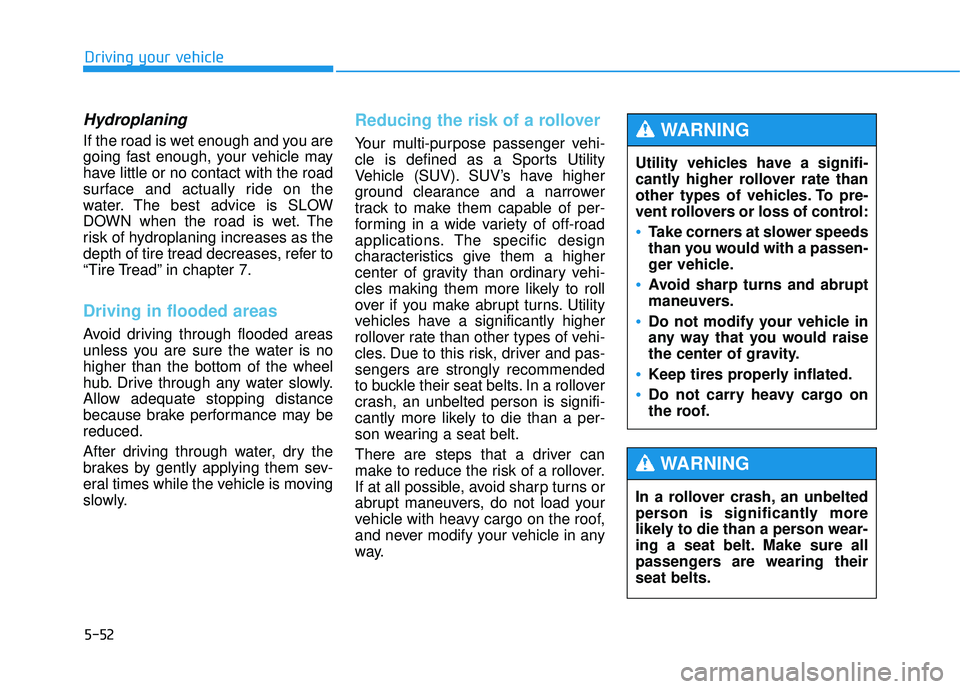
5-52
Driving your vehicle
Hydroplaning
If the road is wet enough and you are
going fast enough, your vehicle may
have little or no contact with the road
surface and actually ride on the
water. The best advice is SLOW
DOWN when the road is wet. The
risk of hydroplaning increases as the
depth of tire tread decreases, refer to
“Tire Tread” in chapter 7.
Driving in flooded areas
Avoid driving through flooded areas
unless you are sure the water is nohigher than the bottom of the wheel
hub. Drive through any water slowly.
Allow adequate stopping distance
because brake performance may bereduced.
After driving through water, dry the
brakes by gently applying them sev-
eral times while the vehicle is moving
slowly.
Reducing the risk of a rollover
Your multi-purpose passenger vehi-
cle is defined as a Sports Utility
Vehicle (SUV). SUV’s have higher
ground clearance and a narrower
track to make them capable of per-
forming in a wide variety of off-road
applications. The specific design
characteristics give them a higher
center of gravity than ordinary vehi-
cles making them more likely to roll
over if you make abrupt turns. Utility
vehicles have a significantly higher
rollover rate than other types of vehi-
cles. Due to this risk, driver and pas-sengers are strongly recommended
to buckle their seat belts. In a rollover
crash, an unbelted person is signifi-
cantly more likely to die than a per-
son wearing a seat belt.
There are steps that a driver can
make to reduce the risk of a rollover.
If at all possible, avoid sharp turns or
abrupt maneuvers, do not load your
vehicle with heavy cargo on the roof,
and never modify your vehicle in any
way.Utility vehicles have a signifi-
cantly higher rollover rate than
other types of vehicles. To pre-
vent rollovers or loss of control:
Take corners at slower speeds
than you would with a passen-
ger vehicle.
Avoid sharp turns and abrupt
maneuvers.
Do not modify your vehicle in
any way that you would raise
the center of gravity.
Keep tires properly inflated.
Do not carry heavy cargo on
the roof.
WARNING
In a rollover crash, an unbelted
person is significantly more
likely to die than a person wear-
ing a seat belt. Make sure all
passengers are wearing theirseat belts.
WARNING
Page 564 of 653
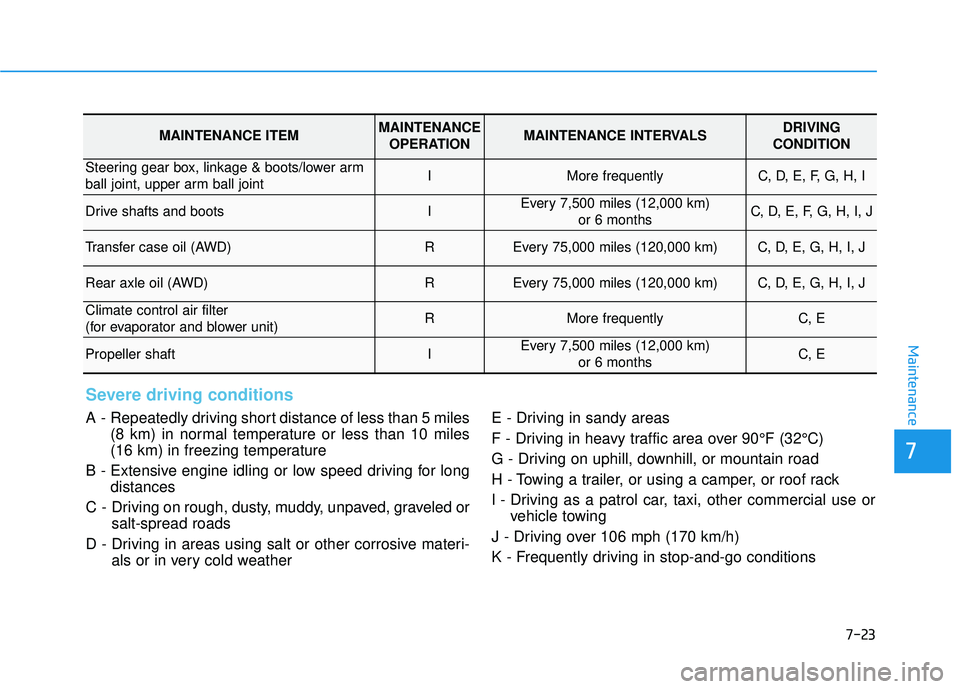
7-23
7
Maintenance
Severe driving conditions
A - Repeatedly driving short distance of less than 5 miles(8 km) in normal temperature or less than 10 miles
(16 km) in freezing temperature
B - Extensive engine idling or low speed driving for long distances
C - Driving on rough, dusty, muddy, unpaved, graveled or salt-spread roads
D - Driving in areas using salt or other corrosive materi- als or in very cold weather E - Driving in sandy areas
F - Driving in heavy traffic area over 90°F (32°C)
G - Driving on uphill, downhill, or mountain road
H - Towing a trailer, or using a camper, or roof rack
I - Driving as a patrol car, taxi, other commercial use or
vehicle towing
J - Driving over 106 mph (170 km/h)
K - Frequently driving in stop-and-go conditions
MAINTENANCE ITEMMAINTENANCE OPERATIONMAINTENANCE INTERVALSDRIVING
CONDITION
Steering gear box, linkage & boots/lower arm
ball joint, upper arm ball jointIMore frequentlyC, D, E, F, G, H, I
Drive shafts and bootsIEvery 7,500 miles (12,000 km) or 6 monthsC, D, E, F, G, H, I, J
Transfer case oil (AWD) REvery 75,000 miles (120,000 km)C, D, E, G, H, I, J
Rear axle oil (AWD)REvery 75,000 miles (120,000 km)C, D, E, G, H, I, J
Climate control air filter
(for evaporator and blower unit)RMore frequentlyC, E
Propeller shaftIEvery 7,500 miles (12,000 km) or 6 monthsC, E
Page 637 of 653
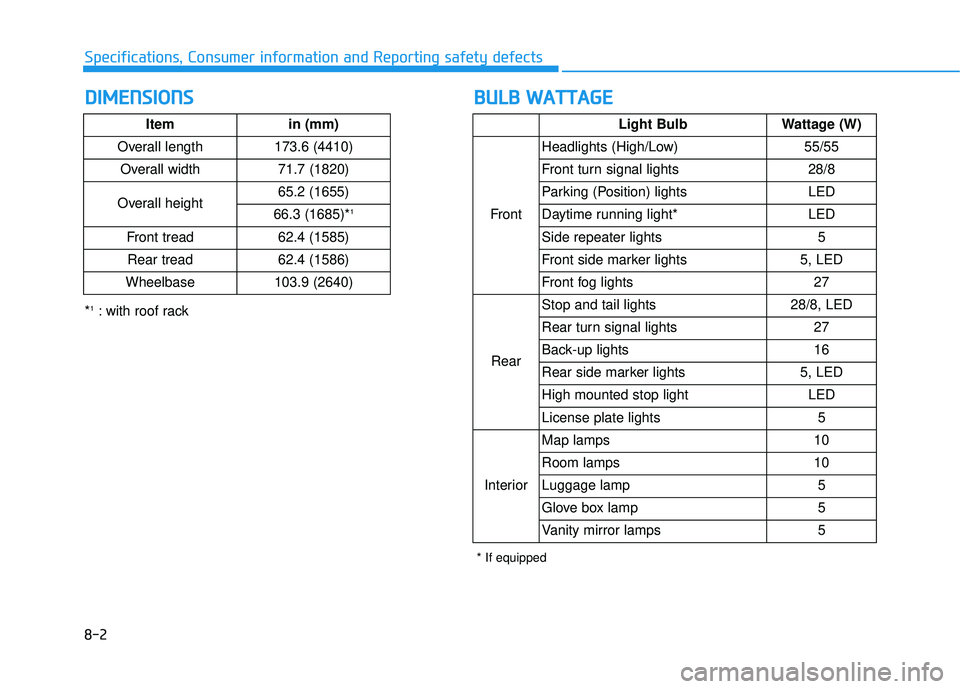
DDIIMM EENN SSIIOO NNSS
8-2
Specifications, Consumer information and Reporting safety defects
*1
: with roof rack
BB UU LLBB WW AATTTTAA GG EE
Item in (mm)
Overall length 173.6 (4410) Overall width 71.7 (1820)
Overall height 65.2 (1655)
66.3 (1685)*
1
Front tread 62.4 (1585) Rear tread 62.4 (1586)
Wheelbase 103.9 (2640)
Light Bulb Wattage (W)
Front Headlights (High/Low) 55/55
Front turn signal lights 28/8
Parking (Position) lights LED
Daytime running light* LED
Side repeater lights 5
Front side marker lights 5, LED
Front fog lights 27
Rear Stop and tail lights 28/8, LED
Rear turn signal lights 27
Back-up lights 16
Rear side marker lights 5, LED
High mounted stop light LED
License plate lights 5
Interior Map lamps 10
Room lamps 10
Luggage lamp 5
Glove box lamp 5
Vanity mirror lamps 5
* If equipped
Page 651 of 653
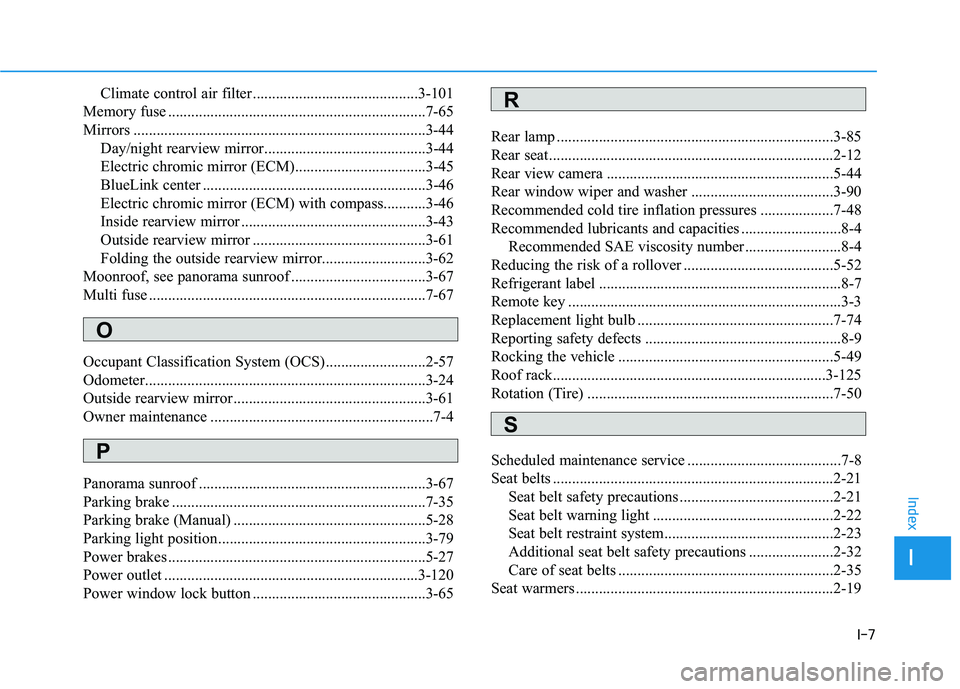
I-7
Climate control air filter ...........................................3-101
Memory fuse ...................................................................7-65
Mirrors ............................................................................3-44 Day/night rearview mirror..........................................3-44
Electric chromic mirror (ECM)..................................3-45
BlueLink center ..........................................................3-46
Electric chromic mirror (ECM) with compass...........3-46
Inside rearview mirror ................................................3-43
Outside rearview mirror .............................................3-61
Folding the outside rearview mirror...........................3-62
Moonroof, see panorama sunroof ...................................3-67
Multi fuse ........................................................................7-67
Occupant Classification System (OCS)..........................2-57
Odometer.........................................................................3-24
Outside rearview mirror..................................................3-61
Owner maintenance ..........................................................7-4
Panorama sunroof ...........................................................3-67
Parking brake ..................................................................7-35
Parking brake (Manual) ..................................................5-28
Parking light position......................................................3-79
Power brakes ...................................................................5-27
Power outlet ..................................................................3-120
Power window lock button .............................................3-65 Rear lamp ........................................................................3-85
Rear seat..........................................................................2-12
Rear view camera ...........................................................5-44
Rear window wiper and washer .....................................3-90
Recommended cold tire inflation pressures ...................7-48
Recommended lubricants and capacities ..........................8-4
Recommended SAE viscosity number .........................8-4
Reducing the risk of a rollover .......................................5-52
Refrigerant label ...............................................................8-7
Remote key .......................................................................3-3
Replacement light bulb ...................................................7-74
Reporting safety defects ...................................................8-9
Rocking the vehicle ........................................................5-49
Roof rack.......................................................................3-125
Rotation (Tire) ................................................................7-50
Scheduled maintenance service ........................................7-8
Seat belts .........................................................................2-21
Seat belt safety precautions ........................................2-21
Seat belt warning light ...............................................2-22
Seat belt restraint system............................................2-23
Additional seat belt safety precautions ......................2-32
Care of seat belts ........................................................2-35
Seat warmers ...................................................................2-19
I
Index
O
R
S
P